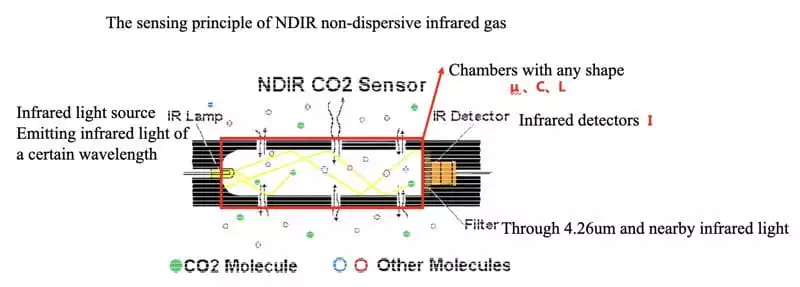
The infrared light source radiates infrared light (Io), and after being absorbed by the gas such as CO2 to be detected in the gas chamber, the intensity of the infrared light reaching the infrared detector will decrease (I), and the C02 molecule will absorb the infrared light with a wavelength of 4.26um. Determine the values of constant parameters such as I0, u, L and the functional relationship between I and C, and then calculate the concentration C of the gas by collecting the corresponding values of several groups of I (detection of the detector) and C (standard instrument tests) through tests based on Beer Lambert's law
Bill Lambert's Law: I=Io.exp(-uCL)
I: Infrared light intensity reaches the detector when there is gas absorption.
I0: Light intensity without gas absorption
C: The concentration of gas in the chamber
L: The length of the chamber or path length of infrared light (length of the yellow line)
u: The absorption coefficient of the gas, which is related to the properties of the gas.
Bill Lambert's Law: I=Io.exp(-uCL)
I: Infrared light intensity reaches the detector when there is gas absorption.
I0: Light intensity without gas absorption
C: The concentration of gas in the chamber
L: The length of the chamber or path length of infrared light (length of the yellow line)
u: The absorption coefficient of the gas, which is related to the properties of the gas.
Single-channel VS dual-channel, the detection accuracy of the dual-channel is higher.
Disadvantages of the single channel: Io will decrease over time, but the functional relationship between I and C is fixed. The detection accuracy decreases.
Advantages of the dual-channel: The value of I0 is corrected through the reference channel, and the detection accuracy is higher.
Disadvantages of the single channel: Io will decrease over time, but the functional relationship between I and C is fixed. The detection accuracy decreases.
Advantages of the dual-channel: The value of I0 is corrected through the reference channel, and the detection accuracy is higher.


Previous: Atmospheric Particles
Next: Applications of Sensors in Smart Home Environment Monitoring




